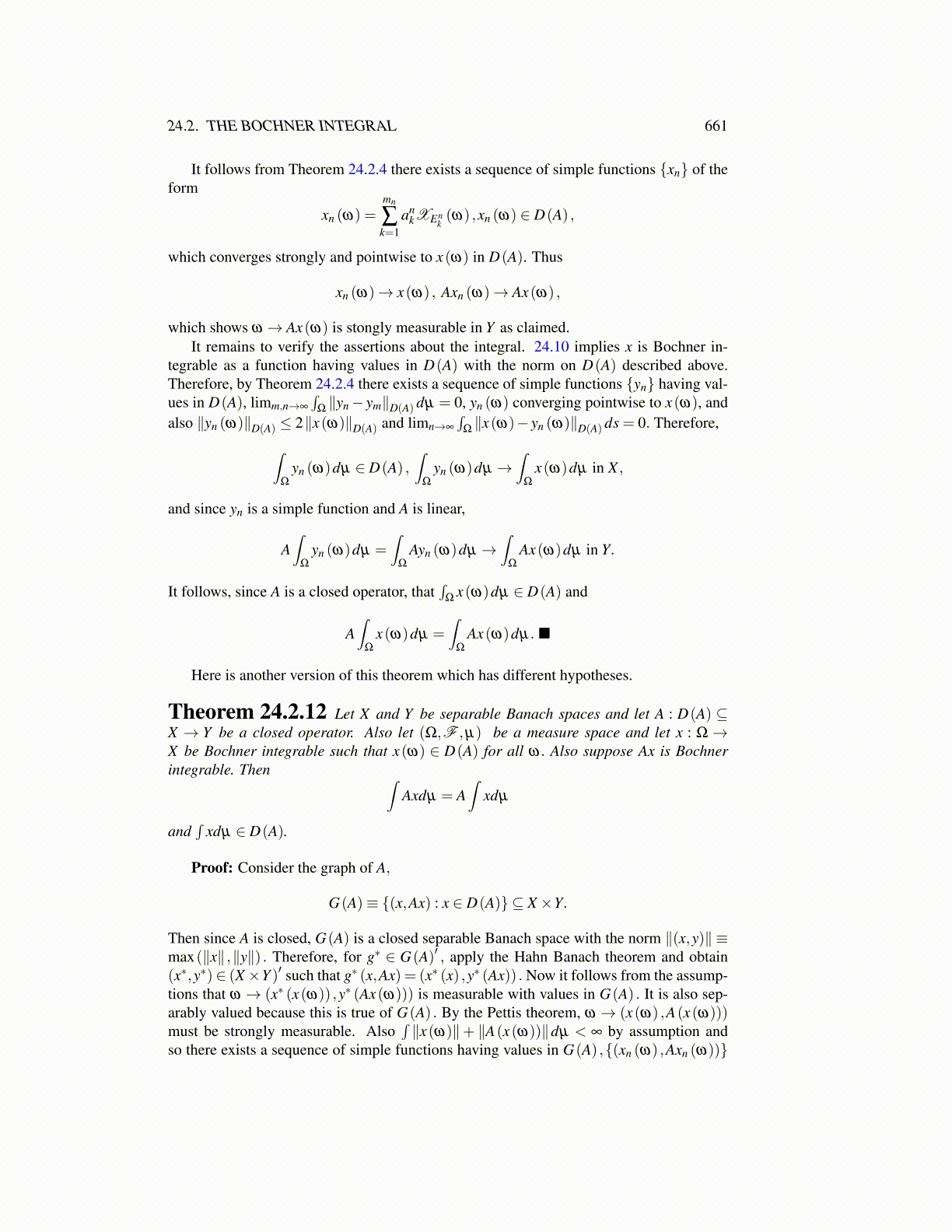
24.2. THE BOCHNER INTEGRAL 661
It follows from Theorem 24.2.4 there exists a sequence of simple functions {xn} of theform
xn (ω) =mn
∑k=1
ankXEn
k(ω) ,xn (ω) ∈ D(A) ,
which converges strongly and pointwise to x(ω) in D(A). Thus
xn (ω)→ x(ω) , Axn (ω)→ Ax(ω) ,
which shows ω → Ax(ω) is stongly measurable in Y as claimed.It remains to verify the assertions about the integral. 24.10 implies x is Bochner in-
tegrable as a function having values in D(A) with the norm on D(A) described above.Therefore, by Theorem 24.2.4 there exists a sequence of simple functions {yn} having val-ues in D(A), limm,n→∞
∫Ω∥yn− ym∥D(A) dµ = 0, yn (ω) converging pointwise to x(ω), and
also ∥yn (ω)∥D(A) ≤ 2∥x(ω)∥D(A) and limn→∞
∫Ω∥x(ω)− yn (ω)∥D(A) ds = 0. Therefore,∫
Ω
yn (ω)dµ ∈ D(A) ,∫
Ω
yn (ω)dµ →∫
Ω
x(ω)dµ in X ,
and since yn is a simple function and A is linear,
A∫
Ω
yn (ω)dµ =∫
Ω
Ayn (ω)dµ →∫
Ω
Ax(ω)dµ in Y.
It follows, since A is a closed operator, that∫
Ωx(ω)dµ ∈ D(A) and
A∫
Ω
x(ω)dµ =∫
Ω
Ax(ω)dµ. ■
Here is another version of this theorem which has different hypotheses.
Theorem 24.2.12 Let X and Y be separable Banach spaces and let A : D(A) ⊆X → Y be a closed operator. Also let (Ω,F ,µ) be a measure space and let x : Ω→X be Bochner integrable such that x(ω) ∈ D(A) for all ω. Also suppose Ax is Bochnerintegrable. Then ∫
Axdµ = A∫
xdµ
and∫
xdµ ∈ D(A).
Proof: Consider the graph of A,
G(A)≡ {(x,Ax) : x ∈ D(A)} ⊆ X×Y.
Then since A is closed, G(A) is a closed separable Banach space with the norm ∥(x,y)∥ ≡max(∥x∥ ,∥y∥) . Therefore, for g∗ ∈ G(A)′ , apply the Hahn Banach theorem and obtain(x∗,y∗)∈ (X×Y )′ such that g∗ (x,Ax) = (x∗ (x) ,y∗ (Ax)) . Now it follows from the assump-tions that ω → (x∗ (x(ω)) ,y∗ (Ax(ω))) is measurable with values in G(A) . It is also sep-arably valued because this is true of G(A) . By the Pettis theorem, ω → (x(ω) ,A(x(ω)))must be strongly measurable. Also
∫∥x(ω)∥+ ∥A(x(ω))∥dµ < ∞ by assumption and
so there exists a sequence of simple functions having values in G(A) ,{(xn (ω) ,Axn (ω))}